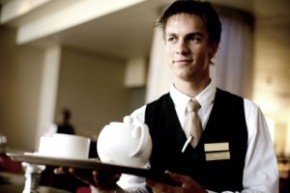 Acknowledging the importance of the customer at any event is crucial. Yoon and Uysal (2005) agree with this statement and highlight that if a customer is satisfied then they are more likely to return to another one of your events or even purchase related products. Berry et al. (1988) identified that service can be the differencing factor between similar events within a competitive industry and an important factor is determining the customer satisfaction.
Acknowledging the importance of the customer at any event is crucial. Yoon and Uysal (2005) agree with this statement and highlight that if a customer is satisfied then they are more likely to return to another one of your events or even purchase related products. Berry et al. (1988) identified that service can be the differencing factor between similar events within a competitive industry and an important factor is determining the customer satisfaction.
What is service quality?
Berry et al. (1988) define quality as the conformance to the customer’s expectations and not of the supervisor’s. Earlier research from Parasuraman et al. (1985) would even suggest that the definition of “quality” has got lost nevertheless like Berry et al. (1988) they still recognise that service is a defining character when understanding customer satisfaction. Getz (2009) identifies that all worker’s, be it volunteers, managers or even people working at the ticket office are instrumental in affecting the perceptions of the customer. This awareness supports Yoon and Uysal (2005) and they would both agree that customer satisfaction influences what they think about an event.
How service quality relates to the real world?
A few months ago I attended a wedding. I was dressed up in my finest attire, obviously looking the part and looking forward to the delicious main course. Then the scrumptious beef dinner was laid out in front of me, “gravy?” the waiter inquired, “of course” I replied. The waiter decided to miss the plate and soak me instead, Smith et al. (1999) would highlight this as a service failure as my perceptions had not meet my expectations and ultimately affected my experience. However, after this incident I was given exceptional service mainly due to the number of free drinks provided by the waiting staff and by the end of the night I had little, to no interest about said gravy palaver. Fritzsimmons and Fritzsimmons (2008) empathise that this was the manager’s method of regaining my loyalty and would identify this tactic as service recovery.
How can we measure service quality in order to improve it?
So, how is service quality measured to ensure that events are maintaining the upmost quality of service enabling the customer to react in a positive manner and reinforce their loyalty? Chingang Nde and Lukong (2010) recognises the fact that it is difficult to measure service as it is subjective variable. Magi and Julander (1996) respond to this by indicating that evaluating the customer’s perception of quality can be achieved via the interaction between the customer and manager. Johnson and Clark (2008) suggest that a questionnaire is a reliable method to achieve this as it provides a written document displaying the customer’s feelings about the service.
There are two theories assigned for measuring service, Chingang Nde and Lukong (2010) indicate the most recent one as SERVPERF which was developed by the work of Cronin and Taylor (1992). This method is based on performance and measures the service quality based on customer’s overall feeling towards service. Chingang Nde and Lukong (2010) suggest that this does not provide information on how customers will prefer service to be in order for service providers to make improvements.
Whereas Parasuraman et al. (1985) theory is constructed via perceptions and expectations of the customer. It is entitled SERVQUAL and was initially determined by ten dimensions but was criticised by Buttle (1996), proposing that it was too complex and not universal. Leading it to be revised to five factors; tangibility, reliability, responsiveness, assurance and empathy. Nevertheless Buttle (1996) did acknowledge the importance of service quality and how it relates to customer satisfaction but also suggests that service quality is entangled with finance via the efficiency of service provided.
Concluding thoughts
Overall, when planning an event, a determining factor is how satisfied the customer is, as this induces loyalty for the business. Getz (2009) notes that satisfaction is based on what kind of service the customer experiences from anyone involved with the running of the event. Parasuraman et al. (1985) theory of SERVQUAL is the most reliable method of analysing customer service as it provides information about both the perceptions and expectations of the customer. Whereas SERVPERF only recognises the performance and does not acknowledge what the customer’s needs and wants are, affecting progression.
Berry, L. L., Parasuraman, A., & Zeithaml, V. A. (1988). The service-quality puzzle. Business Horizons, 31(5), 35-43.
Buttle, F. (1996). SERVQUAL: review, critique, research agenda. European Journal of marketing, 30(1), 8-32.
Chingang Nde, D., & Lukong, P. (2010). Using the SERVQUAL Model to assess Service Quality and Customer Satisfaction.: An Empirical Study of Grocery Stores in Umeå (Doctoral dissertation, Umeå University).
Cronin Jr, J. J., & Taylor, S. A. (1992). Measuring service quality: a reexamination and extension. The Journal of Marketing, 55-68.
Fitzsimmons, J., and Fitzsimmons, M., (2008) Service Management: Operations, Strategy, Information Technology, McGrawHill, USA.
Getz, D., (2009) Event Studies: Theory, research and policy for planned events, Butterworth-Heinmann, Oxford, UK.
Parasuraman, A., Zeithaml, V. A., & Berry, L. L. (1985). A conceptual model of service quality and its implications for future research. The Journal of Marketing, 41-50.
Smith, A. K., Bolton, R. N., & Wagner, J. (1999). A model of customer satisfaction with service encounters involving failure and recovery. Journal of marketing research, 356-372.
Yoon, Y., & Uysal, M. (2005). An examination of the effects of motivation and satisfaction on destination loyalty: a structural model. Tourism management, 26(1), 45-56.